E-E-A-T is not a ranking factor
The QRG is a document provided by Google to their search quality raters, which describes how websites should be rated. If you haven’t read it yet, I highly recommend you do, as it’ll give you a very good idea of the many different guidelines Google raters follow to distinguish between high-quality and low-quality websites.
It’s important to clear up that E-E-A-T is not a ranking factor – as Google isn’t directly using this as a way to rank websites – but simply a concept which encompasses these principles, as shown below:
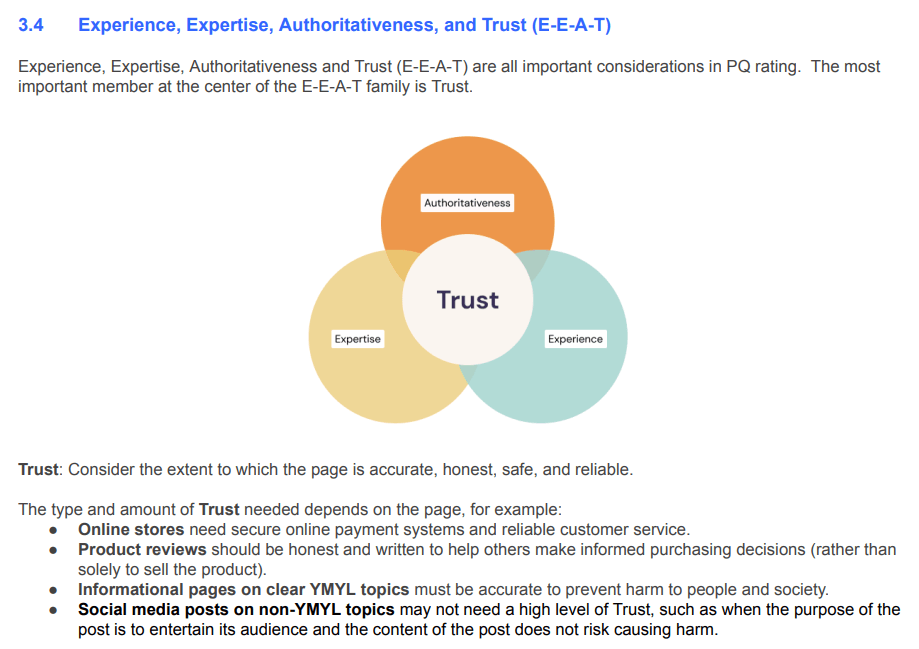
E-E-A-T. Extract from Google’s QRG.
As the QRG explain, E-E-A-T is extremely important for any site that writes on a topic that could be considered ‘Your Money, Your Life’ (YMYL). This acronym refers to websites ranking for queries that can affect people’s health, happiness, or financial stability. Because of the potential negative impact inaccurate information could have on the searcher, Google sets much stricter standards for this type of website, as shown in the below screenshot, taken from Google’s QRG.

E-E-A-T for YMYL topics. Extract from Google’s QRG.
You might be wondering how this relates to your online store. Well, since online shops process sensitive payment information – which presents an element of financial risk to the user – it shouldn’t be a surprise that ecommerce websites fall under the YMYL category (if you aren’t fully convinced yet, have another look at the visibility graph above).
Actionable tactics to improve your ecommerce site’s E-E-A-T
Whilst the fundaments of E-E-A-T are the same for all types of websites, the way you apply this concept to different types of content might vary slightly. We’ve already published a number of E-A-T strategies for financial services websites, and in this guide we include an extensive list of recommendations you can implement to demonstrate a high degree of E-E-A-T on your online store.
Auditing your site for low-quality content
The first thing you should do is review your existing pages with the E-E-A-T guidelines in mind.
Some of the things you should avoid having:
- Pages that don’t have enough main content to satisfy the users’ intent – landing pages failing to rank for the targeted keywords is a sign that this might be a problem
- Content that’s outdated, contains errors, inaccuracies, or spelling mistakes
- Content that has been copied from somewhere else or auto-generated without subsequent manual curation
- Content that doesn’t have an author or whose author does not have the adequate expertise in the given topic
- A website or content creator with a negative reputation
- Not enough information about the website or author, such as missing author bio, or missing links that demonstrate their expertise
- Lack of backlinks
Useful and rich content on your product pages
Your transactional product pages are a really good place to start if you want to improve the quality of your site’s content, and one of the elements which usually gets neglected on this type of page is the product description. This should be unique, as helpful as possible for users, and contain enough information for search engines to understand the page. This means it’s important not to use the same product description across several similar products and to avoid taking descriptions from manufacturers’ sites (something we commonly see across ecommerce clients).
Creating unique product descriptions for every single page on a large ecommerce site can be very time-consuming and, with the recent rise of artificial intelligence, many online stores are starting to use these new tools to create AI-generated content. While this could work if done properly, you’ll need to make sure you pair this with human curation for AI-generated content done by a professional copywriter. Otherwise, you’ll be at risk of getting large amounts of low-quality content – which would be against E-E-A-T guidelines – crawled and indexed by Google. If you don’t have the resources required for this kind of curation, it’s better to hold off and keep your pages as they are.
My colleague Emily has already listed a number of strategies to write optimised product page copy, but below is a brief summary of things to bear in mind when writing your product descriptions to ensure they are useful and unique:
- Include your main target keyword in the description
- Sprinkle in long‐tail variations and synonyms to ensure the content reads naturally
- Use semantically relevant keywords to improve the relevancy towards the main targeted term
- Make sure descriptions are detailed and readable for humans
Furthermore, include as many product characteristics as possible. Think of what makes that product unique. For example, features like:
- Size (or fit, for clothing)
- Colour/print
- What the item is made from
- What it can be used for
- Care instructions
- Sustainability details (where relevant)
All of these characteristics can help you give your product pages the uniqueness they need for a good E-E-A-T. Detailed information at this stage will also aid customers’ decision-making and increase your conversion rate. It’s also a great way to display your expertise to users and search engines while providing a fantastic user experience.
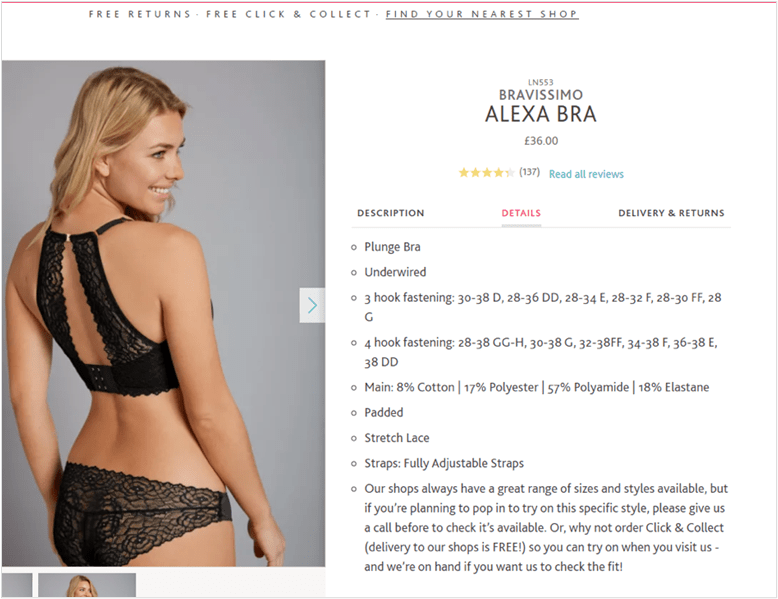
Example of a good product description with lots of details

Example of a great product spec on a HOKA product page
There are a few other elements you can include on your product pages to make them more useful, unique and higher quality. This way you won’t have to rely as much on the product description, which will be particularly helpful for large ecommerce sites where creating unique product descriptions across the whole product stack can be an endless task.
For example, things like incorporating ‘expert options/quotes’ on your product page template, as shown in the below example.
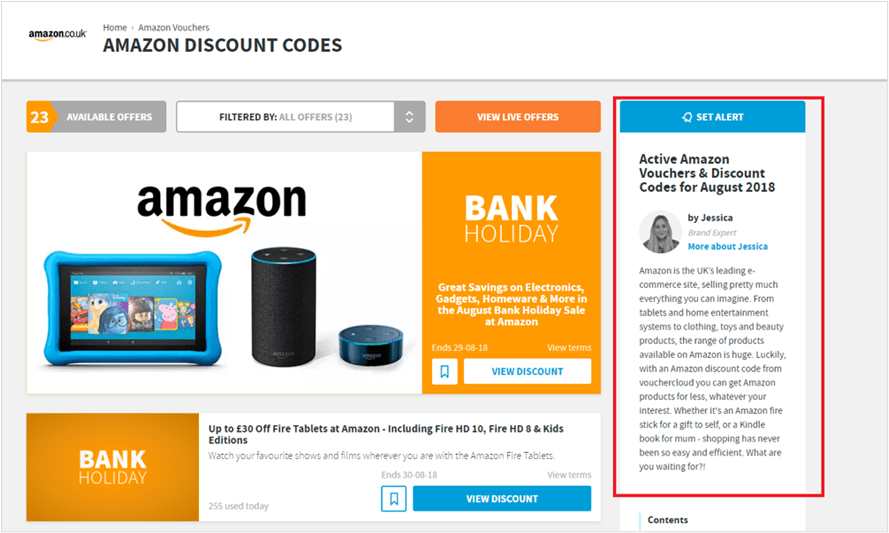
TOTEME’s product pages are also a good example of high-quality, unique and useful content.. They contain details on fit, fabric, , shipping and returns, plus common customer questions, as well as the garment’s country of origin and main supplier information. This is an excellent example of transparency and sending a strong trustworthiness signal to Google, by having content that is relevant and unique.
Example of high-quality, unique content on a TOTEME product page:
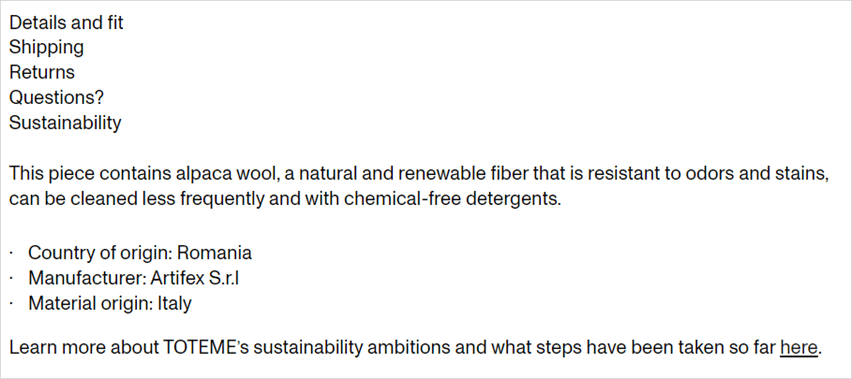
Screenshot taken from TOTEME’S product page.
If you can, consider including rich content and different formats as well, such as videos. In addition to increasing the quality of your pages, when they are well-optimised (with transcript/description, video schema, etc.), videos can also help you cater to long-tail searches, which usually mean higher purchase intent. For example, the keyphrase ‘How to use [product]’ would help you capture potential customers who are interested in buying but aren’t fully convinced yet, as you can see in the example from Huda below.

Usergenerated content (UGC)
You can – and should – go a step further by adding user-generated content to your product page template. When implemented and moderated correctly, this can be a very powerful tool to boost your site’s E-E-A-T as well as increase customer loyalty and trust, which translate into higher conversions.
You can do this in several ways. For example, by allowing and encouraging your customers to leave reviews on your product pages. This type of UGC can be one of the best ways to add unique, fresh and relevant content to your pages at scale, as users will typically include your targeted terms in their reviews. Furthermore, reviews are seen as an endorsement of trust by Google.
Below there is an example of a product page with customer that showcase a number of keywords relevant to the targeted topic:
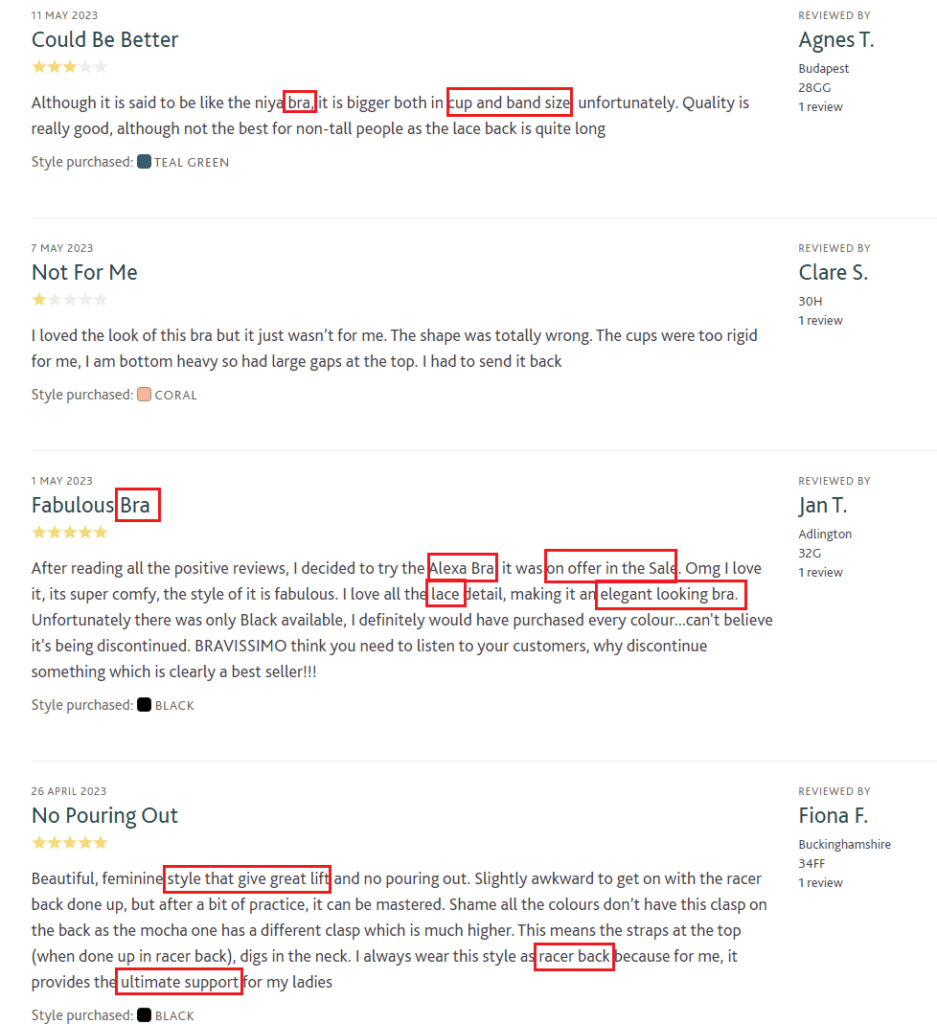
In the screen grab below, you can see how a site operating in the beauty industry allows customers to upload pictures of the products in use. This is another great example of UGC. Besides helping to convince undecided customers to buy your products, this is also a great way to add trustworthiness to your site.

Answering user questions with FAQs and Q&As
Ensuring customers receive top-quality customer service should be at the core of every ecommerce site as it plays a very important part in optimising for E-E-A-T. Creating a community where existing customers give advice to new ones (and advocate for you) is an excellent way to achieve this. It will help you build customer trust and loyalty, which will also have a positive effect on your conversion rates.
You can see an example of this below:
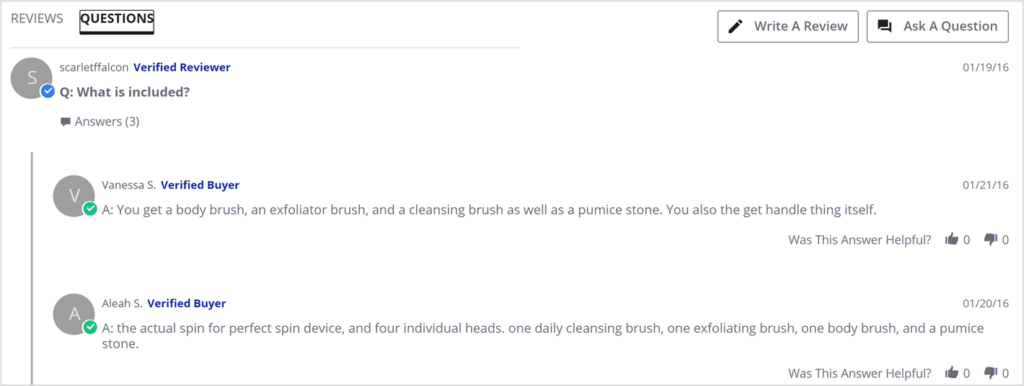
Questions and answers section on an ecommerce product page.
You can go a step further and use the FAQ Schema to tell search engines that your content is FAQs. While Google does not currently use Schema.org structured data as a direct ranking factor, this will help your site gain a better presence in Google search, as they do use this data to generate rich snippets which will increase your site’s CTRs.
Clear contact details and customer service information
Great customer service is essential to your ecommerce site’s success, as it leads to higher customer satisfaction, loyalty, and increased conversions. As an online shop, you need to make sure you have very clear and helpful contact information so that your buyers can easily reach you. This is a huge indicator of trust, for both users and search engines. At a minimum, I recommend you have:
- An optimised ‘contact us’ page that allows visitors to contact you easily. This should be reachable from every page on the site (e.g., sitewide link on the footer)
- Visible phone number (e.g., at the top of the page)
- Chat for customer support accessible sitewide
- Site-wide ‘contact us’ section (e.g., as part of the footer)
Below is an example of a great Contact us section inserted above the footer (sitewide) on an ecommerce website:
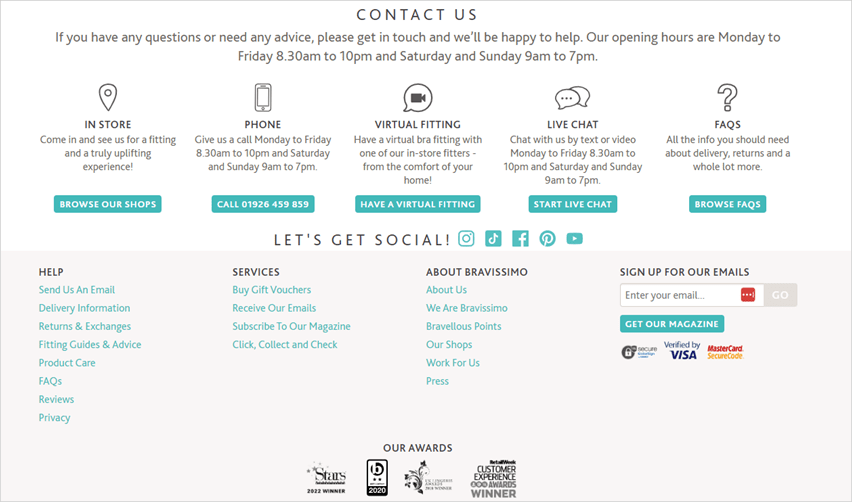
Having a useful ‘help and support’ section to answer your customer questions is also really important for your brand image, which will in turn contribute to higher conversion rates. Additionally, this first layer of passive support will help prevent your customer service staff from being bombarded with the same, often simple, questions over and over again.
Shopify’s help centre is a great example of this. It contains a list of help areas clearly categorised, helping their users easily find what they are looking for.

To ensure this is as helpful as possible, you need to make sure to include answers to your users’ most commonly asked questions, as illustrated in the example below.

Information on payment terms and refund policy
Having transparent delivery and returns information explained across all your transactional pages is a strong indicator of trust. Add a brief description of your delivery, returns and refund policies on your product pages and include a link to the ‘returns policy’ and ‘delivery’ pages to add more context. If you have a ‘payments FAQ’ page, add a link to this as well. If you don’t, consider creating one.
Payment logos – such as Visa or PayPal – are particularly important for online shopping sites as well. These should go on the footer across the entire site and include a link to your ‘payment terms’ page.
Awards and achievements
If you have won any awards, you should shout about these on your website. Make sure you display award badges prominently across your site – or, at a minimum, on transactional pages and in your About Us section. In addition, make sure to publish editorial content to promote your achievements as much as possible. This is the type of content the QRG raters will look at when evaluating your website.
You can accompany this by showing positive testimonials of your brand from your clients, too. This kind of evidence reinforces your positive reputation and is a great way to improve your E-A-A-T.
Extensive ‘About us’ content
As a trusted and reputable online shopping site, you should include extensive information about your brand. At a minimum, you should have a detailed ‘About us’ page, reachable from every page on your site, with details on brand history, purpose, contact information, awards and achievements..
This type of content plays a significant role in E-E-A-T as it improves your site’s credibility and give visitors confidence that they’re shopping on a trustworthy and reputable site.
If possible, you should also have a ‘Meet the team’ section, where you can include bios and photos of your team of experts. This will help showcase your brand’s expertise, and it’s a big signal of trust.

Example of great ‘About Us’ content on an ecommerce store.
Including bios of your content creators is another great way of boosting your site’s authoritativeness and trustworthiness. Make sure you include an image of the author, along with the bio and links to other articles they’ve written.
A great example of this is Sustainable Chic:

A solid content strategy to demonstrate E-E-A-T
So far, we have covered a number of strategies to create useful, high-quality content. However, if you really want to demonstrate your authority and expertise within your industry, you will need to take things a step further.
Ideally, you’ll want users going to your site to learn about topics within your industry, and you can achieve this by publishing timely, frequent and fresh content that’s relevant to your products and audience.
To do this, you’ll need a solid content strategy that helps you support your customers through their journey. Add content regularly to show your users and search engines that you are active and still relevant to the topic, and don’t forget to update your existing content as well to ensure your site has the most recent and trustworthy information. Ask yourself what has changed since that was created or what missing information might be useful for your customers now.
Finally, having all of this information structured properly on topical clusters will be crucial to showcase your expertise within those areas and increase your users’ experience. You can achieve this by using internal links to connect related articles in a way that’s useful for your customers. This will also help search engines understand the purpose of your pages.
Top-quality user experience
The QRG document repeatedly refers to the importance of user experience (UX) for E-E-A-T and I’m sure I don’t need to remind you how much this can impact your conversion rates, too. As a minimum, your ecommerce site should meet the following requirements to ensure a good user experience:
- Mobile-friendly website
- Professional-looking layout, with professional photography
- Fast pages that pass the CWV scores (particularly important on your transactional and checkout pages)
- User-friendly faceted navigation, with helpful product filters buyers will care about
- Clean and intuitive navigation with relevant sections and subsections, and rich internal linking to connect relevant pages through the site
Maintaining your website’s functionality through excellent technical SEO foundations will also have a significant impact on its E-E-A-T. Ensuring you don’t have broken links leading users – and search engines – to 404 URLs is the bare minimum, so review your product retirement strategy and ensure different types of expired content on your site are being managed appropriately.
Furthermore, as you already know, HTTPS provides a more secure connection than the non-secure HTTP protocol and, as an ecommerce site processing payment information for your customers, this is crucial for you. For this reason, raters take into account whether a site is on HTTPs or not when evaluating it for E-E-A-T.
Implementing product markup across your product page template will give Google detailed product information they can use to display rich snippets. There are lots of different properties you can add to this schema property, but here are some of the most common, and the ones we recommend adding to your product pages:
Last but not least, you should conduct a log file analysis to ensure Google isn’t wasting crawl rate on duplicate, missing or non-valuable content. You’d be surprised how much crawl budget waste we usually we find when carrying out this analysis for newly retained clients.
As part of this analysis, check that you don’t have too many ‘low-quality’ indexable URLs creating indexation bloat, as these can dilute your overall site quality. Control indexation accordingly and remember that every page that is indexed counts towards Google’s perception of quality.
Earning trust by building links from authoritative sites
Backlinks are still one of the most important SEO ranking signals and, as such, they also play an important role in your E-E-A-T. When someone links back to content on your site, Google sees this ‘vote’ as an endorsement, and takes it into account when measuring a page’s relevancy and trustworthiness. For your backlink strategies to be more effective, you’ll want to build links from sites that are authoritative but also contextually relevant to your niche, as these will carry more weight. They will also contribute to improving your reputation.
Ideally, for these links to be more valuable on ecommerce sites, they should point to your (transactional) product pages rather than the homepage. This is because the homepage already tends to attract most of a site’s backlinks, and by the time link equity from these arrives to deeper product pages via internal links this has already been diluted considerably. Instead, create a strategy to effectively build links at scale to your product pages, so that you get greater value from them.
Likewise, you should conduct a backlink audit to ensure you don’t have unnatural or spammy backlinks hurting your site’s off-page profile. With Penguin 4, Google is supposed to simply ignore low-quality backlinks, but is still worth carrying out a review to ensure that there aren’t any spammy links hurting your site and submit a disavow file to ‘discount’ any backlinks you are not comfortable with.
In summary
Even though E-E-A-T is not a ranking factor directly used by Google as a way to rank sites, it’s undeniable that sites with a good E-E-A-T deliver exceptional value to users and, as a result, tend to perform better in organic search results.
This guide is focused on strategies that are more relevant to ecommerce sites but the fundaments of E-E-A-T stay the same for all types of websites. If you want to optimise your site for Google’s E-E-A-T you’ll need to take into account the aspects of page quality raters are instructed to consider. To sum up, these are:
- The quality of the content
- The expertise and reputation of the author
- The authoritativeness of the content, its author, and the website it is on
- The trustworthiness of the content, its author, and the website it is on
These principles apply to all types of content, but they’re particularly important for ecommerce websites, which fall into the YMYL category. This means that underestimating E-E-A-T can severely hurt your ecommerce store’s organic success.
If you’d like to discuss any aspect of your ecommerce site’s E-E-A-T further, contact our SEO team – we’d love to have a chat!
